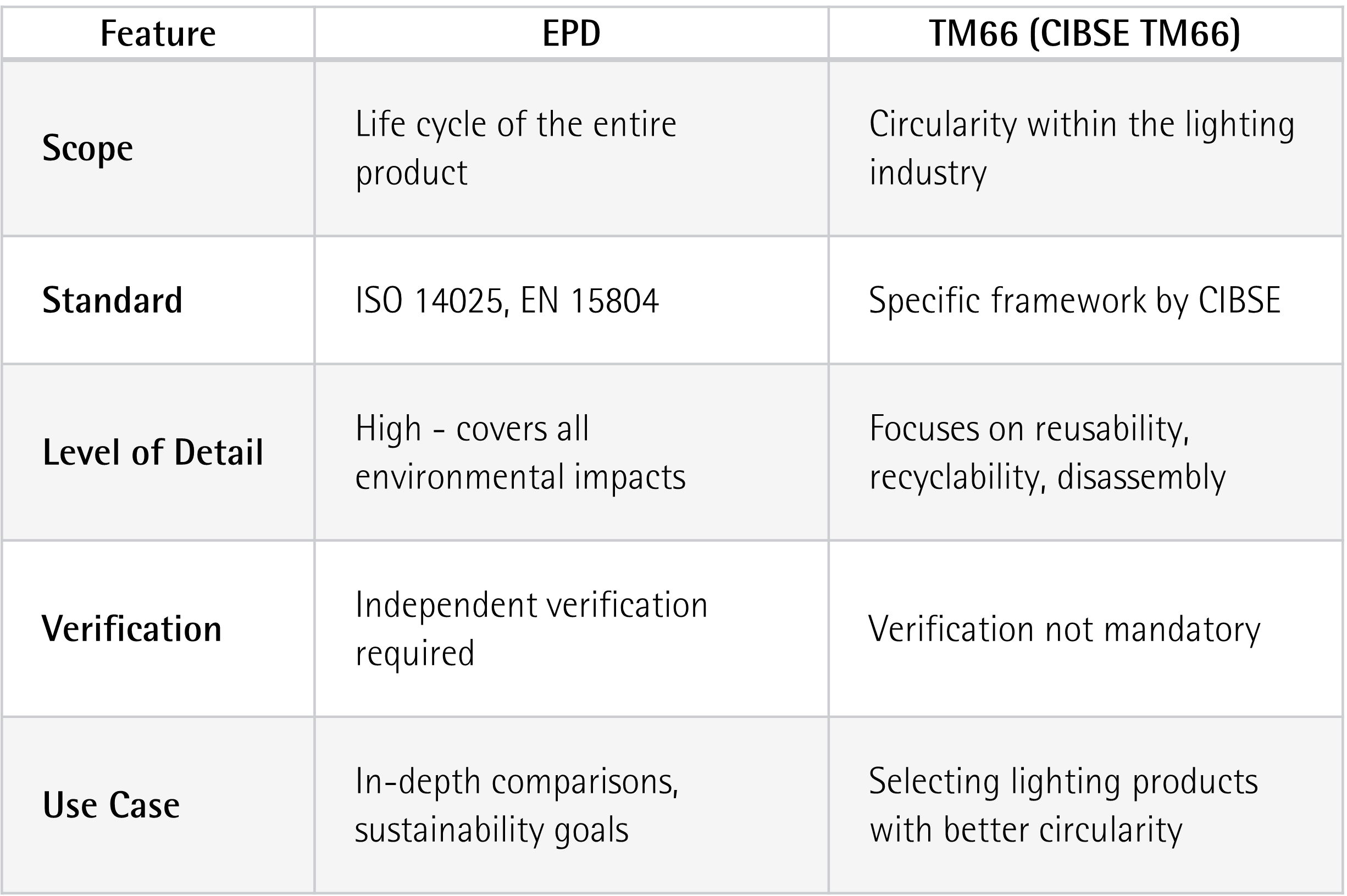EPD 101
Understanding Environmental Product Declarations (EPDs) and their difference from TM66 for Architects, Designers, and Developers.
What is an EPD?
An EPD, or Environmental Product Declaration, is a verified and registered document that transparently communicates the life-cycle environmental impact of a product. It considers factors like resource consumption, energy use, greenhouse gas emissions, and pollution throughout the product's life cycle, from raw material extraction to end-of-life disposal. Think of them as nutrition labels for building products, but for their environmental impact.
There are 3 different types of EPDs:
- Cradle-to-grave EPD: Assesses the environmental impact of a product from raw material extraction to end-of-life disposal.
- Cradle-to-gate EPD: Assesses the environmental impact of a product from raw material extraction to the point of sale.
- Business-to-business EPD: Focuses on the environmental impact of a product within a specific supply chain.
What is TM66?
TM66, formally known as CIBSE TM66, is a methodology developed by the Chartered Institution of Building Services Engineers (CIBSE) to assess the circularity of lighting products. It is a specific framework designed for the lighting industry.
What's the difference between EPDs and TM66?
While both EPDs and TM66 address a product's environmental impact, they differ in scope and focus. An EPD offers a more comprehensive environmental assessment than a TM66. Here's a breakdown of the key differences:
EPD: Offers a comprehensive assessment across a product's entire life cycle covering all environmental aspects, following standardized formats, and undergoing independent verification.
TM66 (CIBSE TM66): A specific framework for assessing a product's circularity within the lighting industry, created by the Chartered Institution of Building Services Engineers (CIBSE). Focuses on a product's design for end-of-life stages, like reusability, recyclability, and disassembly.

What information does an EPD contain?
EPDs follow a specific format (typically ISO 14025 or EN 15804) and include:
- Life Cycle Stages: The environmental impact is assessed across all stages, from raw material acquisition to end-of-life.
- Environmental Impact Indicators: These indicators measure resource use (water, energy), emissions (air, water), and waste generation.
- Additional Information: This may include technical product data and a reference to the independent verifier who reviewed the EPD.
Who uses EPDs?
- Architects and engineers: For specifying eco-friendly building materials.
- Procurement professionals: To make sustainable purchasing decisions.
- Consumers: To understand the environmental footprint of products they buy.
- Governments: To promote green public procurement and eco-friendly practices.
Why are EPDs important for you?
As designers, architects, and developers, you're increasingly called upon to create sustainable projects. Growing green procurement policies and building certifications often require EPDs for product selection. Knowing a product's EPD ensures you're complying with and meeting regulatory requirements.
EPDs also allow you to compare the environmental impact of different lighting options objectively, empowering you to make informed choices about the environmental footprint of your project. This helps you choose products that align with your sustainability goals and contribute to greener projects.
You can compare different lighting options based on factors like:
- Climate change impact: greenhouse gas emissions associated with production and use.
- Resource depletion: how much water, energy, and raw materials are used.
- End-of-life impact: how easily the product can be recycled or disposed of responsibly.
By choosing lighting with lower environmental impact, you can:
- Reduce your project's overall environmental footprint: Every eco-friendly light fixture contributes to a greener built environment.
- Drive demand for sustainable practices: Your choices incentivize manufacturers to prioritize sustainability, leading to better products for everyone.
- Green building certifications: EPDs can help achieve points in LEED, BREEAM, and other green building rating systems.
- Transparency and trust: Demonstrate your commitment to environmentally responsible design.
Who can create an EPD and are they mandatory?
Any manufacturer or brand owner can create an EPD for their product. However, it must be developed according to international standards and verified by an independent third party.
Currently, EPDs are not mandatory in most countries. However, their use is increasingly encouraged by governments, industry initiatives, and green procurement programs. Some companies choose to create EPDs voluntarily to demonstrate their environmental commitment.
How can you read and understand EPDs?
- Functional unit comparison: Focus on the functional unit (e.g., lumens per watt) which defines the product's performance, to make informed choices and for fair comparisons between products.
- Life cycle assessment (LCA) results: Look for key indicators like greenhouse gas emissions, water use, and resource depletion across different life cycle stages. This gives you a holistic view of the product's environmental footprint.
- Context matters: Remember, an EPD only provides information, not a ranking or certification. Consider regional variations, production methods, and additional environmental factors that may not always be included (e.g., biodiversity impact).
How can I learn more about EPDs?
EPDs are publicly available in international databases like the PEP Ecopassport®, and the International EPD System®.
Several organizations offer resources and training on EPDs, including the Environmental Protection Agency (EPA), the Association for Standardization (ISO), and the European Platform for Life Cycle Assessment (PELCA).
Additional Resources:
PEP Ecopassport®: http://www.pep-ecopassport.org
The International EPD System®: https://ibu-epd.com/en/
Remember: EPDs are not rankings. Use them to compare and choose based on your specific project goals and priorities. They are a powerful tool for making informed choices about lighting and contributing to more sustainable buildings. Don't hesitate to ask for them and use them to your advantage!
How can we support you?
Allow us to approach your new project together.
Return